Best Time To Visit Namibia 8 Reasons to Go Now
Last updated on June 18th, 2025 at 05:36 pm
The alarm screamed at 4:45 AM, and I seriously considered throwing it across the tent. My back ached from sleeping on what felt like concrete, and every muscle in my legs reminded me of yesterday’s failed attempt to climb Big Daddy dune. But something about the complete silence outside made me grab my camera and stumble into the pre-dawn darkness of the Namib Desert.
Forty minutes later, I was perched on a smaller dune watching the most incredible sunrise of my life unfold over Sossusvlei. The sand beneath me shifted from deep purple to rose gold, then blazed into the fiery orange that makes Namibia famous on every travel blog. That moment – shivering in the morning cold while watching an ancient landscape come alive – taught me everything about why timing matters in this country.
That was August 2019, during what locals call the heart of winter. I’d picked those dates almost by accident, booking the only vacation time my boss would approve. Lucky accident, as it turned out. Three return trips later, including one disastrous December visit that involved more mud than wildlife, I’ve figured out exactly when this country shows its best face.
Table of Contents
Why Getting the Timing Right Matters for the Best Time to Visit Namibia
Most people think Africa equals hot weather year-round. Wrong. Namibia sits in the southern hemisphere, which means July feels like January back home. Add in elevation changes from sea level to 6,000 feet, plus the world’s oldest desert creating its own weather patterns, and you’ve got climate conditions that swing wildly depending on when you show up.
During my December trip, afternoon thunderstorms turned the roads into rivers. We spent two days stuck at our lodge while 90-degree heat made everyone cranky. The animals scattered to every corner of the park because water was everywhere. Our game drive turned into a very expensive nature documentary about distant specks that might have been antelopes.
Compare that to August, when every waterhole became a natural amphitheater packed with wildlife, and you start understanding why seasons matter here more than almost anywhere else.
Eight Rock-Solid Reasons to Get Your Dates Right
1. Wildlife Viewing Becomes Absolutely Predictable (May Through October)
Here’s something the guidebooks don’t tell you: during Namibia’s dry months, you basically can’t avoid seeing animals. It’s not luck anymore – it’s simple biology.
Water becomes scarce, so every living creature congregates around the permanent waterholes. At Etosha’s Okaukuejo camp, I sat for three hours one evening watching elephants, giraffes, rhinos, and zebras take turns at the floodlit waterhole. The elephants bullied everyone else away. The giraffes waited patiently. The zebras tested the waters (literally) before committing to drink.
Our guide mentioned that during rainy season, these same animals spread across 8,600 square miles of park because temporary water sources pop up everywhere. Good luck finding them then.
What You’ll Actually See More Of:
- Elephant herds gathering in groups of 30+ (dry season vs. small family units in wet season)
- Predator action around water sources (lions know where prey must come)
- Rare species like black rhinos (they have predictable drinking schedules)
- Multiple species interacting (competition for resources creates drama)
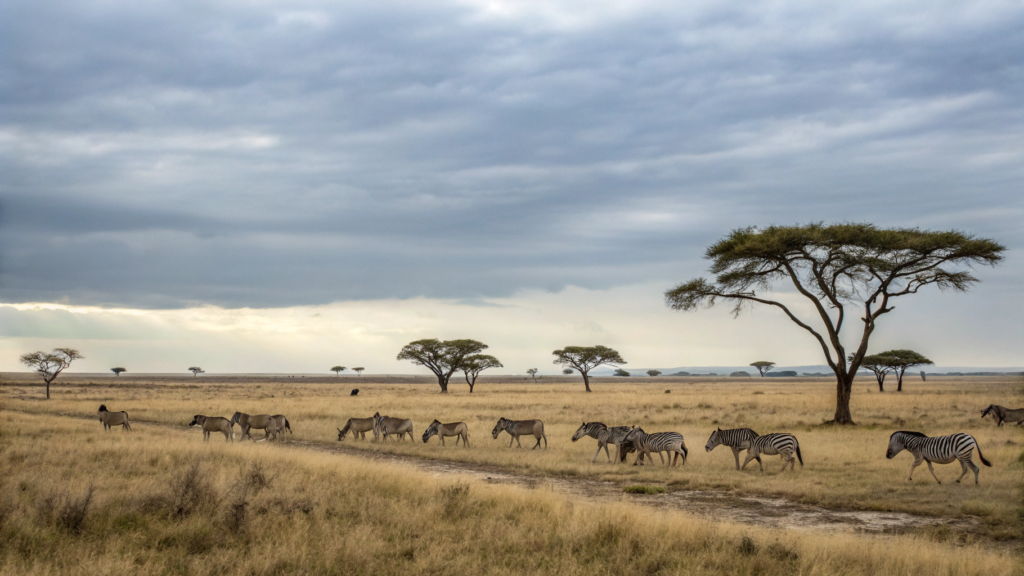

The numbers don’t lie either. Etosha’s own research shows visitor wildlife sighting rates jump from 45% success during wet months to 87% during peak dry season.
2. Photography Stops Being a Gamble
Instagram makes Namibian landscapes look effortless. Those perfect blue skies, razor-sharp dune ridges, and golden light? They’re not accidents or photo editing magic. They’re what happens when you visit during months with virtually zero humidity and minimal cloud cover.
I shot over 2,000 photos during my August trip. Maybe fifty were unusable due to weather conditions. During December? I was lucky if half my shots weren’t ruined by afternoon storms, dust, or hazy skies.
The technical stuff matters too. Low humidity means visibility extends for miles. Dust doesn’t hang in the air. Colors stay saturated instead of washed out. Even smartphone cameras produce shots that look professional.
Photography Gold Mine Months:
Time PeriodClear DaysVisibility DistanceLight QualityJune-July28-30 days20+ milesExceptionalAugust-September25-28 days15-20 milesExcellentOctober-November20-25 days10-15 milesGoodDecember-March10-20 days5-10 milesVariable
Sunrise and sunset last longer during winter months too. Instead of rushed 20-minute golden hours, you get nearly an hour of perfect light each morning and evening.
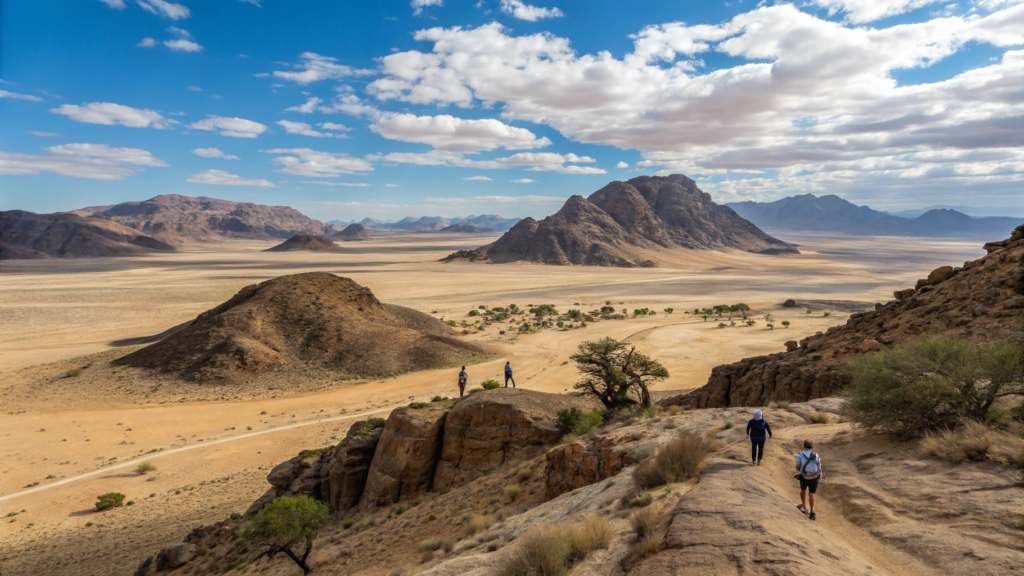

3. Temperatures Stop Trying to Kill You
Let’s talk honestly about heat. Namibian summer doesn’t mess around. I’ve experienced 115°F days that made stepping outside feel like opening an oven door. Sand becomes too hot to touch. Car door handles burn your palm. Even locals stay indoors during midday hours.
Winter temperatures, though? Perfect for humans who want to actually do things.
Real Temperature Ranges (Not Tourist Brochure Nonsense):
Dry Season Reality (May-October):
- Morning starts: 40-50°F (bring layers!)
- Midday peaks: 70-80°F (comfortable hiking weather)
- Evening cooling: 55-65°F (perfect for campfires)
Wet Season Reality (November-April):
- Morning starts: 65-75°F (already warm)
- Midday peaks: 85-105°F (dangerous for outdoor activities)
- Evening temps: 70-85°F (too warm for comfortable sleeping)
During my February attempt at dune climbing, the sand measured 140°F by 10 AM. I literally couldn’t stand on it barefoot. Compare that to July mornings when the sand feels cool enough to walk on comfortably until noon.
4. Safari Experiences Go From Good to Legendary
Etosha National Park during dry season operates like a wildlife soap opera. Limited water sources create natural gathering spots where animal behavior becomes intensely dramatic and totally predictable.
At Goas waterhole one evening, we watched a territorial dispute between two elephant matriarchs that lasted forty minutes. Neither would back down. Other animals waited in a semi-circle like spectators at a boxing match. Eventually the older female asserted dominance through pure attitude and body language. The younger one retreated with her family, but not before throwing what can only be described as an elephant tantrum.
You don’t see this kind of concentrated drama when water sources are abundant everywhere.
Dry Season Safari Advantages:
- Concentrated viewing: Animals use predictable routes to water
- Behavioral observations: Resource competition reveals natural hierarchies
- Photographic opportunities: Animals stay put longer at water sources
- Multiple species interactions: Predator-prey relationships become obvious
Park statistics back this up. Visitor logs show average wildlife sightings per game drive jumping from 12 species during wet season to 23 species during peak dry months.
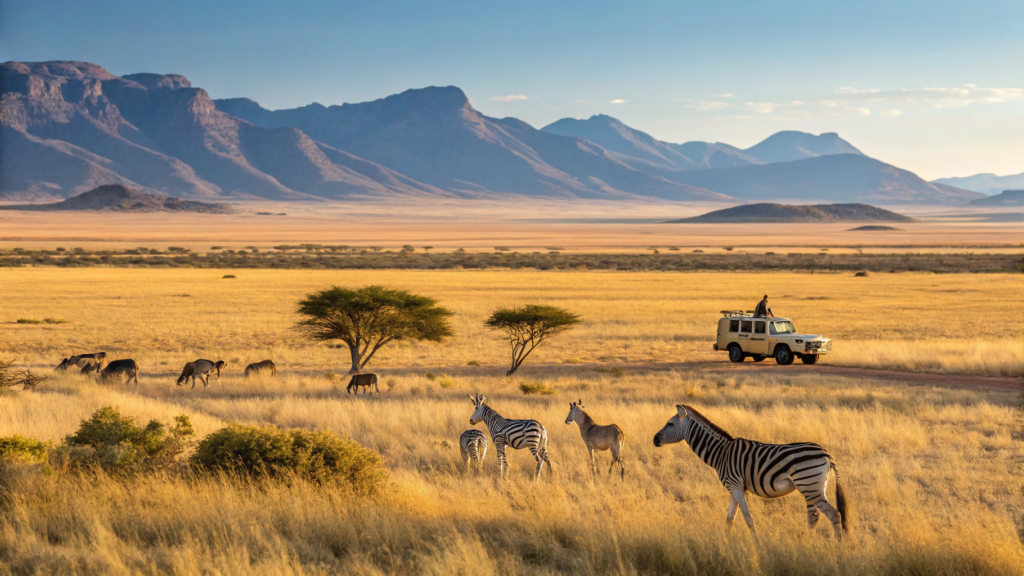

5. Desert Adventures Become Actually Possible
The Namib Desert earned its reputation as one of Earth’s most inhospitable places. But timing your visit right transforms it from survival challenge to bucket-list experience.
Sossusvlei’s massive dunes demand serious physical effort to climb. Big Daddy stands 1,066 feet tall with slopes that make your legs scream. During summer months, this becomes genuinely dangerous as sand temperatures soar above 150°F and heat exhaustion becomes a real risk.
Winter climbing feels completely different. Cool sand, comfortable air temperatures, and stable weather conditions turn the same dunes into challenging but manageable adventures.
Desert Activity Sweet Spots:
AdventurePerfect MonthsWhy It WorksDune climbingJune-AugustSand cool enough to touch, manageable air tempsDesert hikingMay-SeptemberNo risk of heat exhaustionOvernight campingApril-OctoberComfortable sleeping temperaturesStar photographyMay-SeptemberConsistently clear, dry skies
Pro insight: Even during ideal months, start desert activities before sunrise. You’ll get the best light for photos and avoid afternoon heat buildup completely.
6. Your Money Goes Further (If You’re Smart About It)
Everyone assumes dry season means expensive travel. Partially true, but the full story offers better options for budget-conscious travelers.
Peak season (July-August) definitely costs premium prices. But shoulder months like May, September, and early October deliver 85% of the dry season benefits at significantly lower costs.
During my September visit, I paid 35% less for the same lodge that cost me a fortune in July. Flights were cheaper. Restaurant specials were common. Tour operators offered package deals they wouldn’t consider during peak months.
Real Budget Breakdown:
- Peak Season (July-August): Highest prices, book 8+ months ahead, premium everything
- Sweet Spot (May, September-October): 25-40% savings, easier booking, same great weather
- Bargain Season (November-April): 50%+ savings, but significant weather compromises
The trick is understanding that “shoulder season” in Namibia often provides better conditions than peak season in many other destinations.
7. Adventure Activities Align With Physics and Common Sense
Namibia offers some unique outdoor experiences you can’t find anywhere else. But extreme temperatures, weather patterns, and seasonal wind conditions determine whether these activities are enjoyable or miserable.
Take hot air ballooning over the Namib Desert. Companies operate year-round, but wind patterns during dry season create far more stable conditions. During wet season, afternoon thunderstorms and unpredictable wind shears often force last-minute cancellations.
Sandboarding down 500-foot dunes sounds thrilling until you realize summer sand temperatures can cause second-degree burns. Quad biking becomes dangerous when dust storms reduce visibility to a few feet.
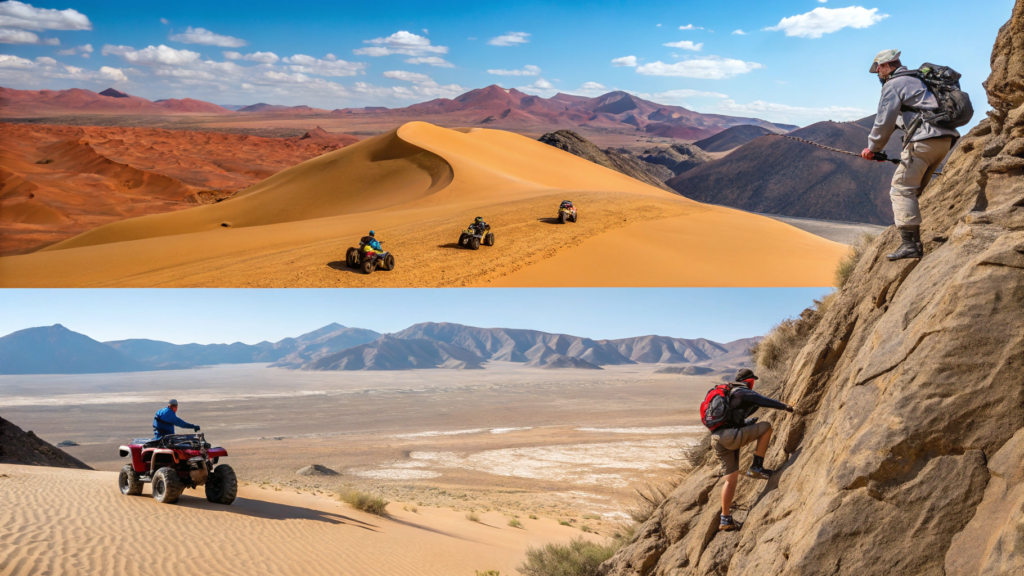

Activity Success Rates by Season:
- Sandboarding: 95% success rate (May-September) vs. 60% (November-April)
- Hot air ballooning: 90% success rate (April-October) vs. 65% (wet season)
- Rock climbing: Best conditions June-August when temperatures stay reasonable
- Multi-day hiking: Only comfortable during winter months
8. Cultural Experiences Flow With Local Life Rhythms
Something I didn’t expect: traditional communities in Namibia organize their lives around seasonal patterns, which affects when cultural tourism works best.
Himba communities in northern Namibia become much more accessible during dry months when roads stay passable. During wet season, rivers can cut off entire villages for weeks at a time. San Bushmen walking tours work better when temperatures allow for comfortable multi-hour outdoor experiences.
Even urban cultural attractions operate differently. Craft markets expand their offerings during tourist season when artisans focus on production. Local festivals often align with harvest cycles or tourist-friendly weather.
Cultural Activity Timing:
- Village visits: May-October (accessible roads, comfortable walking)
- Traditional demonstrations: June-September (optimal outdoor conditions)
- Craft markets: Best selection during dry season
- Local festivals: Many coincide with tourist season for practical reasons
Month-by-Month Truth Telling
Let me share what each season actually feels like based on multiple visits:
June-August (Tourist Season Peak): Reality check: Yes, it’s more expensive. Yes, popular spots get crowded. But the weather is absolutely perfect, wildlife viewing reaches its peak, and every activity runs smoothly. If this is your only Namibia trip, these months justify the extra cost.
September-October (The Sweet Spot): My personal favorite time. Weather stays excellent, wildlife concentration continues, but crowds thin out significantly after European school holidays end. Prices drop 25-35% while conditions remain nearly as good as peak season.
November-February (Wet Season Gamble): Dramatically cheaper, greener landscapes, great for bird enthusiasts. But afternoon thunderstorms happen almost daily, roads become questionable, and heat can be oppressive. Only recommended for return visitors or those with very specific interests.
March-April (Transition Months): Unpredictable. You might catch the tail end of rains or get lucky with early dry season conditions. Prices start dropping, but weather remains a gamble.
Making Your Decision
After experiencing Namibia across different seasons, here’s my straight advice:
First-time visitors: Pick June through September. You came to see Africa at its best, not to save money on a compromised experience. The memories from perfect conditions will last longer than budget concerns.
Return visitors or serious budget travelers: May or September offer tremendous value. You’ll experience 90% of peak season conditions while saving 30% on costs.
Adventure photographers or wildlife enthusiasts: July-August provides the most consistent conditions, despite higher prices.
Bird watchers or budget backpackers: February-April can be magical if you’re prepared for weather challenges and have flexible plans.
The Real Bottom Line
Namibia works any time of year, but your experience quality varies dramatically based on when you arrive. The difference between visiting during ideal conditions versus challenging weather isn’t just comfort – it’s access to the experiences that make this country special.
That sunrise from Dune 45 happened because I visited when morning temperatures were cool enough for pre-dawn climbing, skies were clear enough for perfect light, and weather was stable enough for early morning photography. During wet season, thunderstorms, high humidity, or extreme heat would have made that moment impossible.
Choose your dates based on what matters most to you. But understand that in Namibia, timing isn’t just about convenience – it’s about accessing the full magic this incredible country offers.
What’s Your Namibia Dream?
Every traveler heads to Namibia with different priorities. Some want perfect wildlife photography. Others seek adventure activities or budget-friendly exploration. A few chase the unique experience of camping under some of the world’s darkest skies.
Whatever draws you to this remarkable country, I’d love to hear about it. Are you planning your first visit, or returning for another taste of Namibian magic? What questions do you have about timing your adventure for maximum impact?
The travel community here always shares great insights, and comparing notes about this incredible destination never gets old. Drop a comment about your Namibia plans, experiences, or concerns – I read and respond to every one.
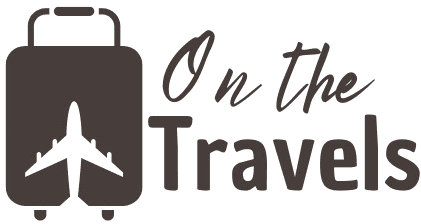
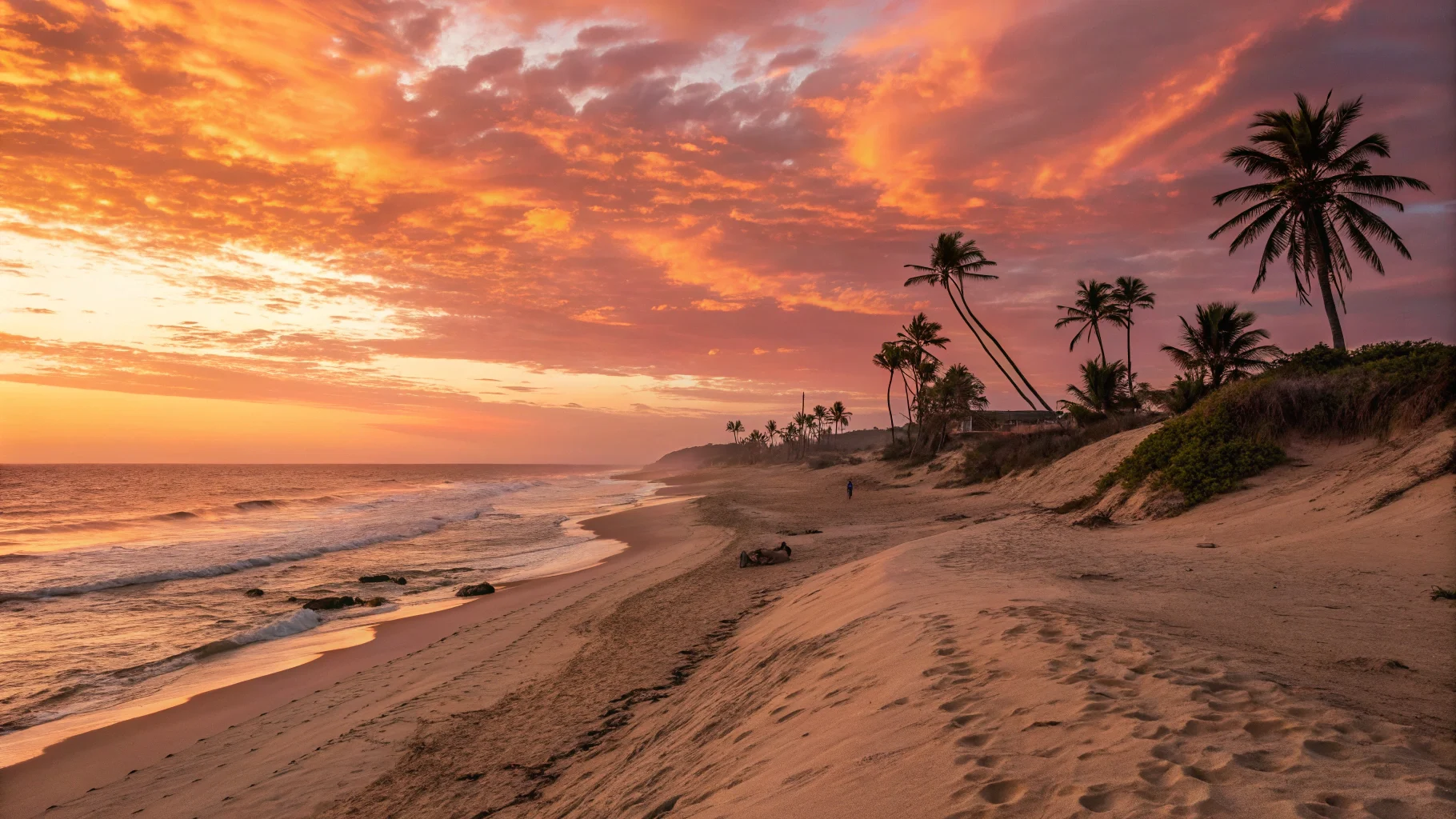

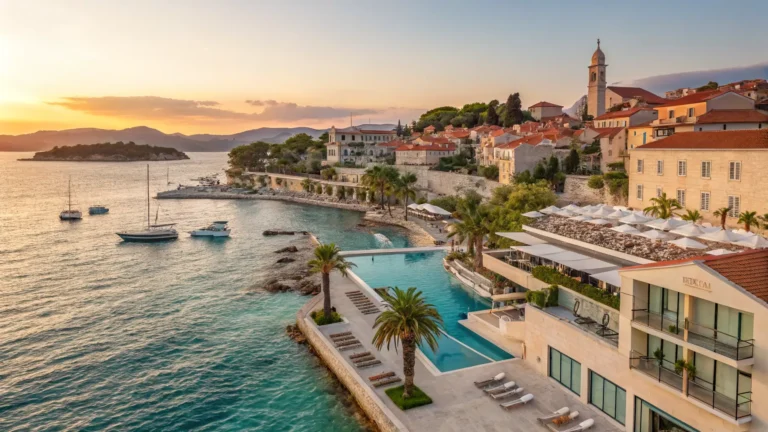
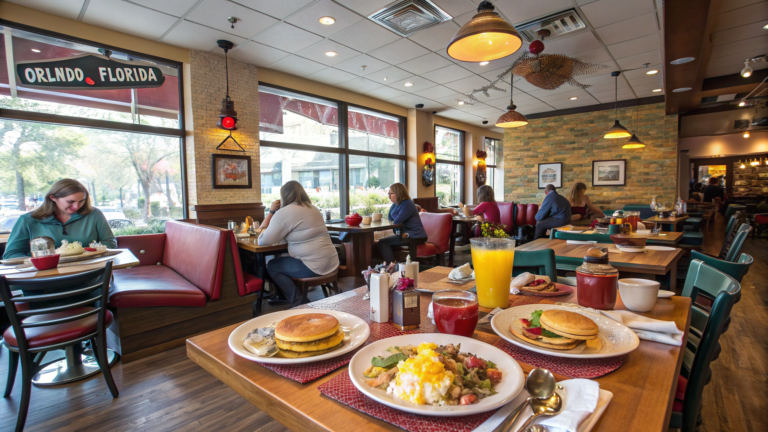
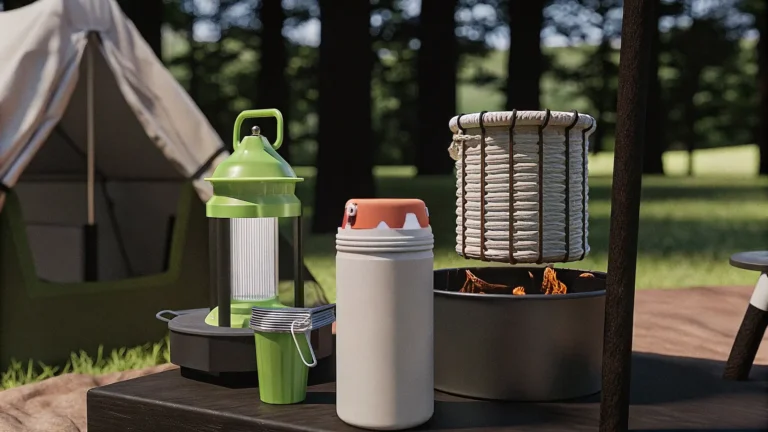
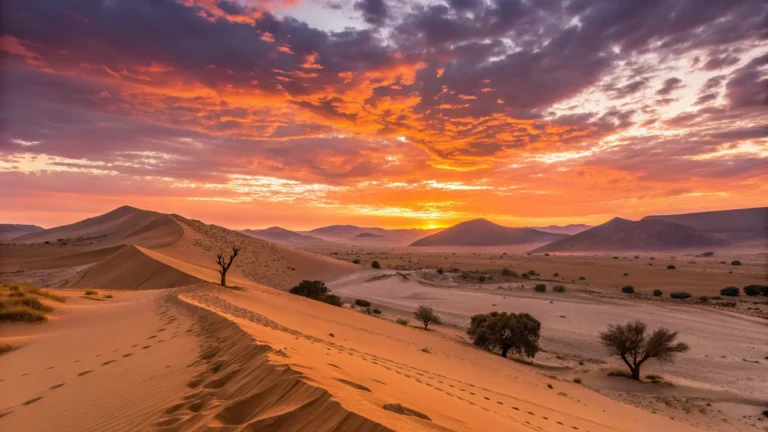
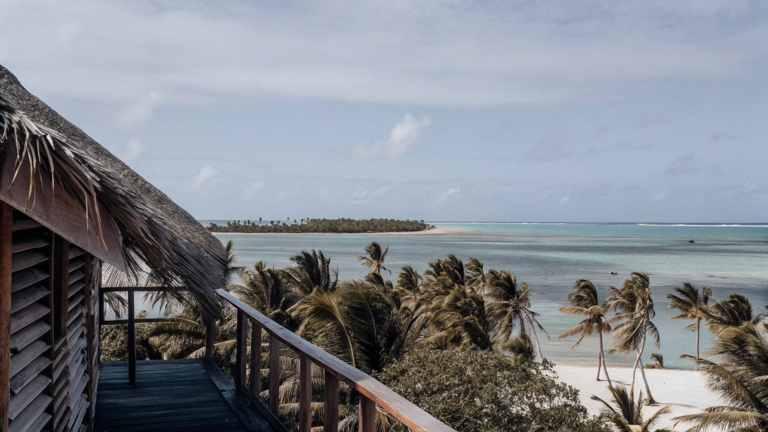
One Comment